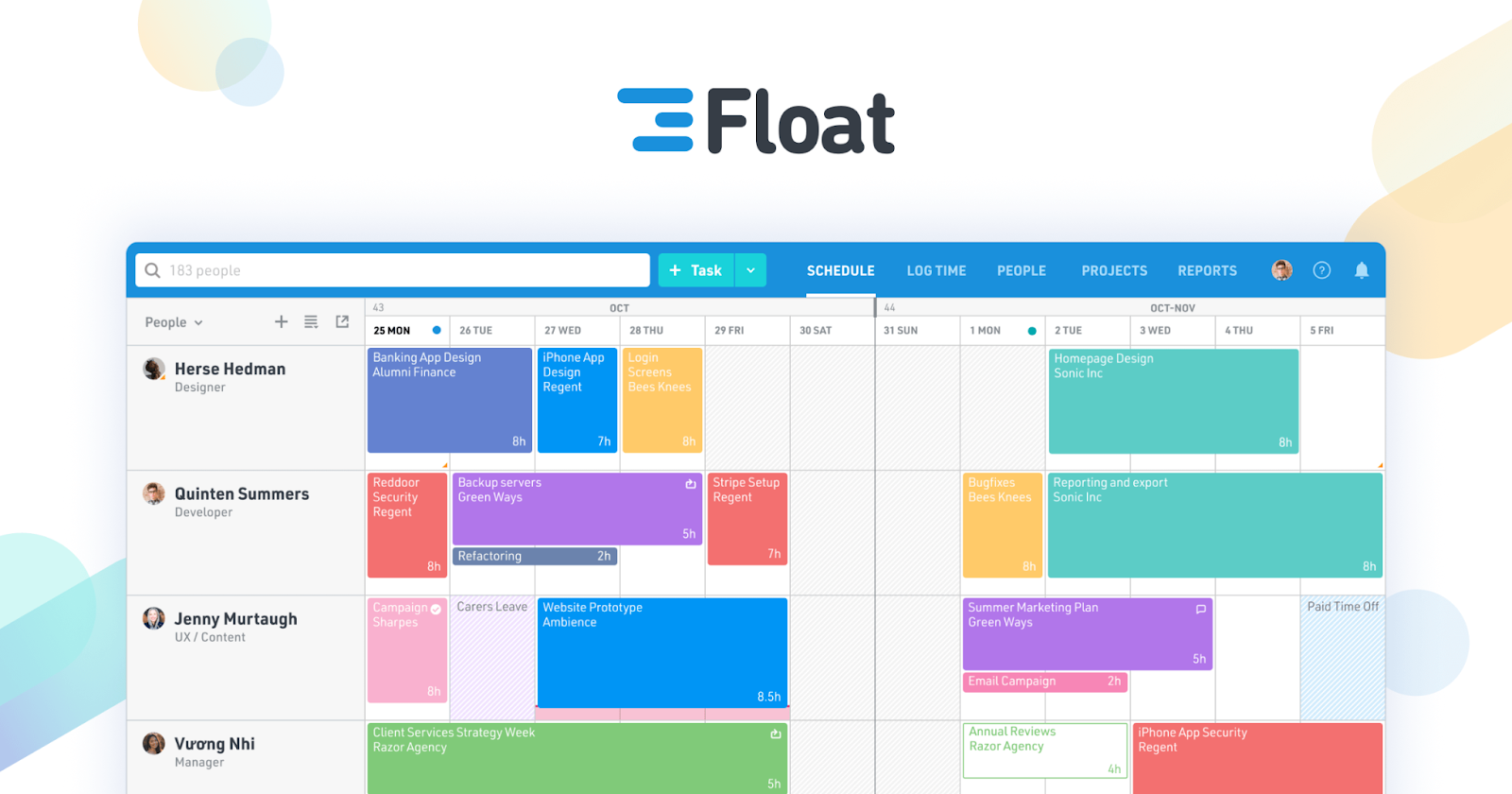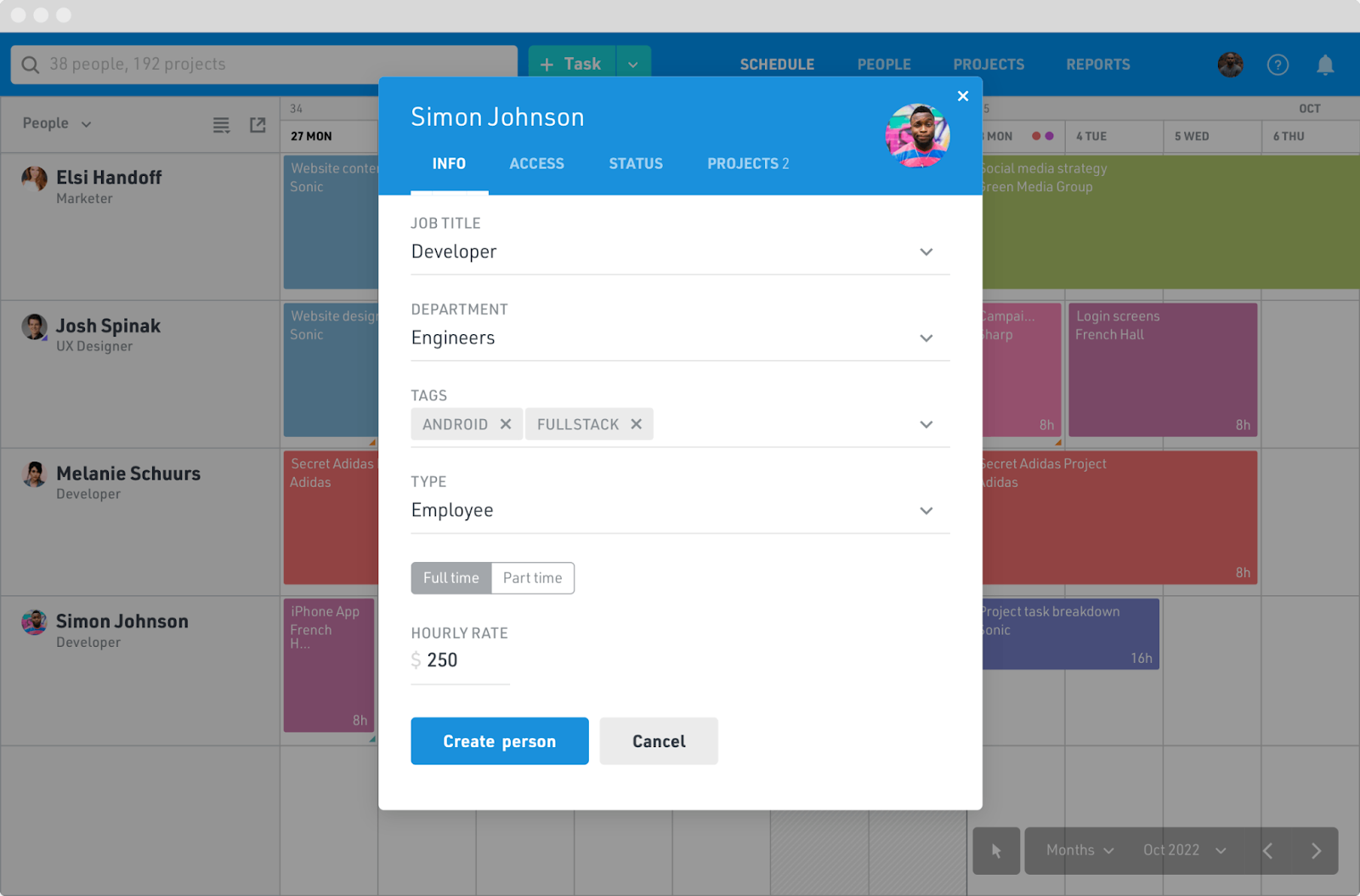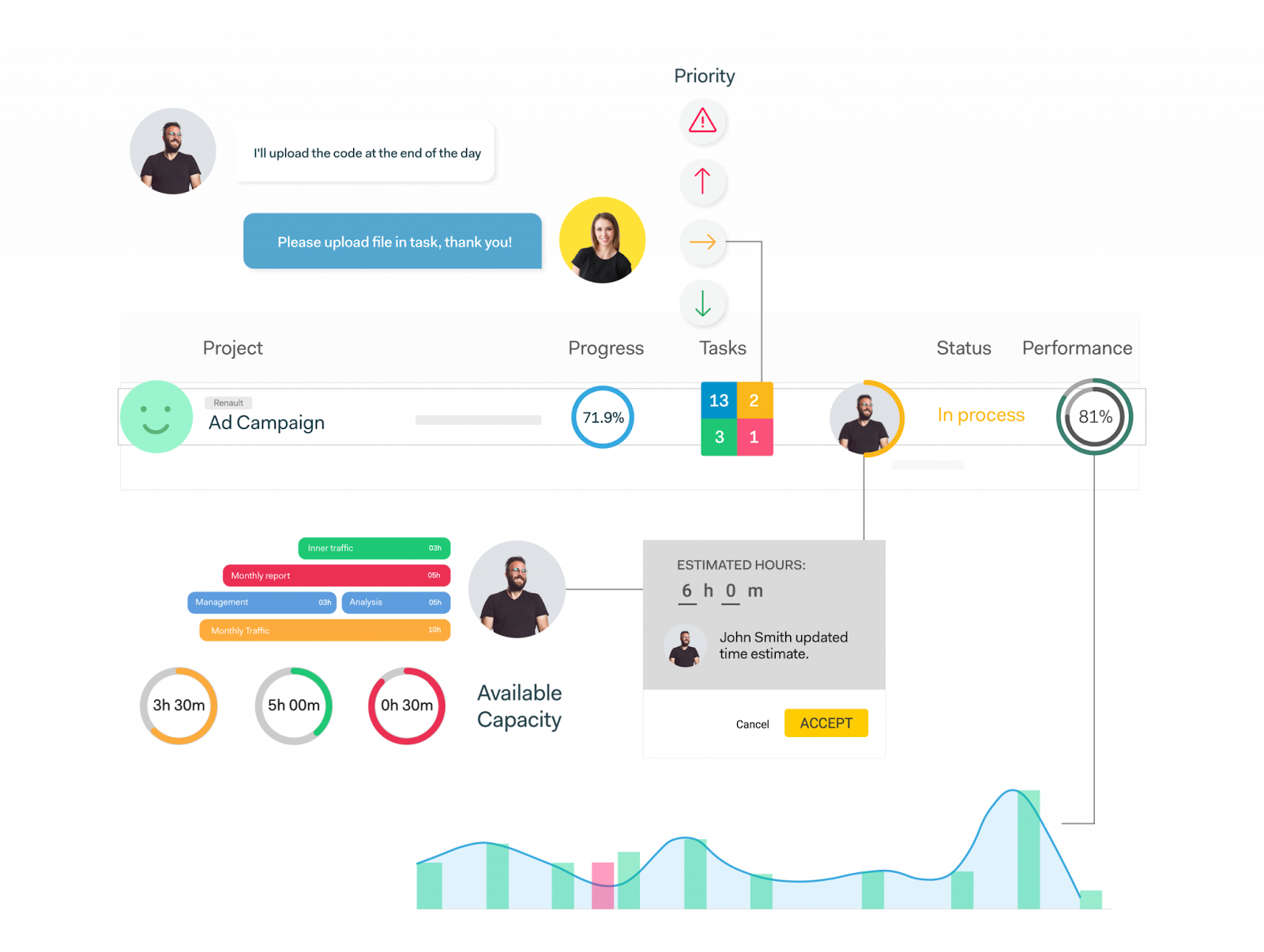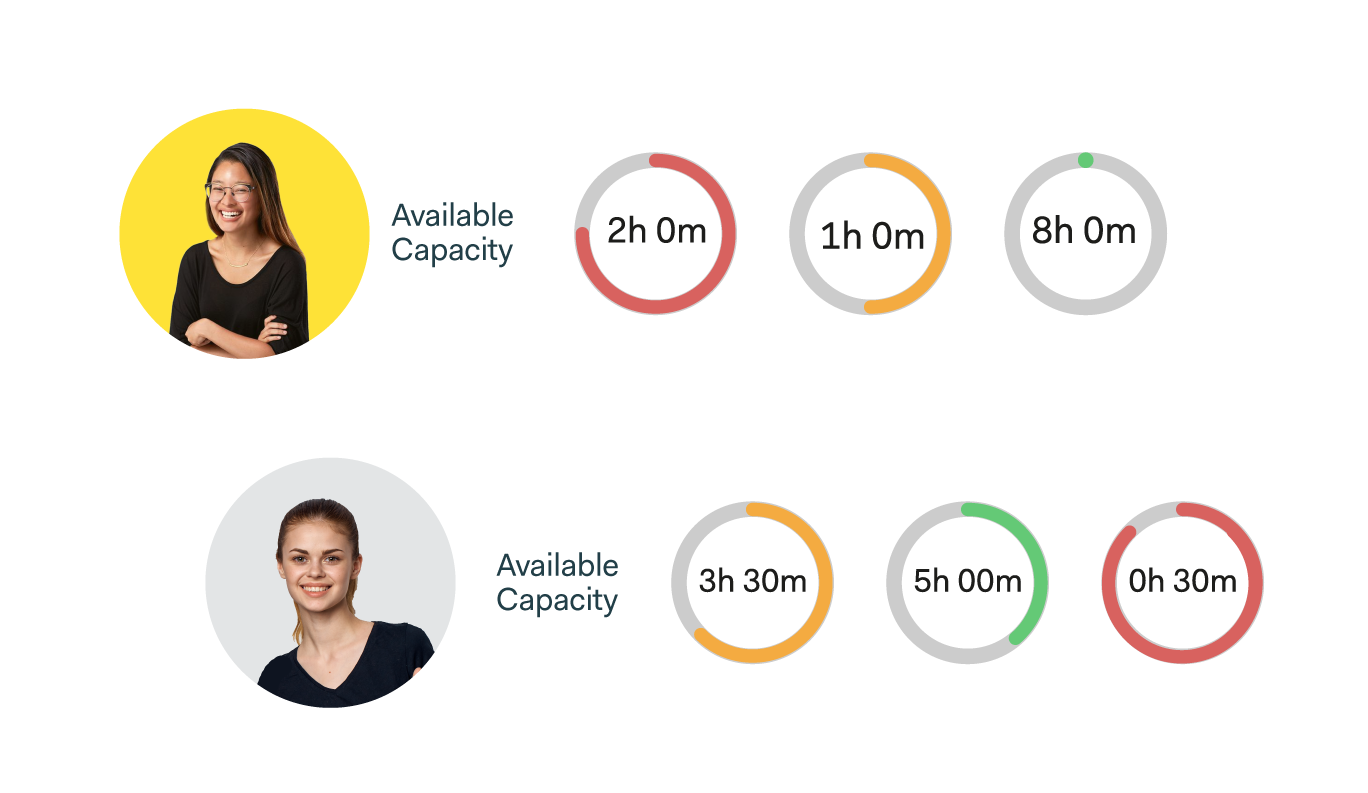Nel mondo degli affari, possiamo identificare diverse risorse critiche che determinano la crescita dell'azienda. Una delle più importanti è la capacità, cioè quanto si può fare in un determinato tempo. Un fattore così importante non può essere trascurato, ed è per questo che sono stati sviluppati molti strumenti di gestione della capacità. Ma come scegliere il migliore?
In questo articolo imparerete:
La gestione della capacità non è un compito semplice, soprattutto perché questo fattore è composto da diversi altri che interagiscono tra loro. Il numero di dipendenti, il loro tempo, la loro disponibilità e le loro competenze: ognuno di questi dati influenza la capacità della vostra azienda. Ecco perché gli strumenti di pianificazione della capacità sono importanti.
Non è facile da comprendere con soli dieci dipendenti. E se la vostra organizzazione conta 100 o 200 persone? Per evitare colli di bottiglia, caos e frustrazione, è necessario il supporto di un'applicazione dedicata, in particolare il campo di battaglia di ogni membro del processo di pianificazione delle risorse.
Il ruolo fondamentale della capacità delle risorse e degli strumenti di pianificazione della capacità
L'equilibrio tra le risorse disponibili (dipendenti) e le richieste del progetto o del cliente - per molti è l'essenza della pianificazione della capacità (o gestione della capacità, se preferite) nella gestione dei progetti. L'importanza della pianificazione della capacità è dovuta alla sua forte connessione con le altre aree della gestione dei progetti: tempo, team, lavoro e gestione delle risorse del progetto. Ma iniziamo con una domanda generale sulla capacità.
La capacità è definita come la capacità di ottenere, immagazzinare o produrre. Per un'organizzazione, la capacità sarebbe la capacità di un dato sistema di produrre output entro un determinato periodo di tempo.
La "capacità di raggiungere" sembra essere la domanda essenziale della pianificazione della capacità, soprattutto se la confrontiamo con le definizioni che seguono. Cercare di dare un'ottima e giustificata risposta alla domanda "abbiamo la capacità di raggiungere?" non è mai un problema ed è fonte di continua ispirazione per fare ottimizzazioni, analisi e così via. Ecco perché gli strumenti di pianificazione della capacità possono essere utili.

Ricerca di risorse basata sulle competenze [Fonte: Teamdeck - Strumento di gestione delle risorse e pianificazione della capacità].
Per sapere se la vostra azienda o un particolare dipendente ha sufficienti competenze hard e soft che non vi deluderanno - che saranno definite come "capacità di realizzazione" - dovete essere molto vicini a lui/lei.
Il tempo dedicato a determinati compiti, la disponibilità o la maturità e l'esperienza prevista in un determinato settore: questi sono alcuni dei criteri presi in considerazione durante il pianificazione della capacità delle risorse processo durante il quale cercherete di capire se una risorsa è un motivo per pensare che il dipendente indicato, o il vostro team, o la vostra azienda abbiano una "capacità di realizzazione", soprattutto con gli strumenti di pianificazione della capacità.
Definizione di pianificazione della capacità e importanza degli strumenti di pianificazione della capacità
Per rendere il tutto più difficile, tutto ciò che sappiamo è che siamo in un ambiente commerciale. Quindi il tempo non è il solo e unico indicatore che determina le vostre decisioni. E secondo il nostro concorrente - il fornitore di strumenti per la pianificazione della capacità - con cui siamo d'accordo:
La pianificazione della capacità è il processo di gestione che assicura che la vostra organizzazione abbia le competenze e le risorse necessarie per completare i progetti nei tempi, nei budget e secondo le aspettative dei clienti.
Questa definizione evidenzia che le risorse (dipendenti) accuratamente qualificate devono affrontare 3 sfide: tempo (limitato), budget (limitato) e aspettative del cliente (in altre parole, le richieste del progetto). O, in un altro modo, queste competenze devono essere sufficientemente valide per aiutare a risolvere le sfide menzionate. Il ruolo di chi è responsabile della pianificazione della capacità è quello di garantire un numero accurato di dipendenti accuratamente qualificati. In questo contesto, gli strumenti di pianificazione delle capacità sono importanti.
Pianificazione della capacità e importanza degli strumenti di pianificazione della capacità
Parte del processo di pianificazione della capacità consiste nell'identificare ciò che abbiamo e quanto velocemente e dove possiamo ottenere risorse precise.
La pianificazione della capacità è un processo che identifica se avete o meno le risorse e le competenze per svolgere il lavoro, o l'offerta per soddisfare la domanda.
Come vediamo, gestione della capacità non è un compito semplice, soprattutto perché questo fattore è composto da diversi altri che interagiscono tra loro. Il numero di dipendenti, il loro tempo, la disponibilità, la produttività, l'utilizzo e le competenze hard e soft: ognuno di questi dati influenza la capacità della vostra azienda. Ecco perché i migliori strumenti di pianificazione della capacità possono essere d'aiuto.
È difficile da comprendere con soli 5 dipendenti. E se la vostra organizzazione conta 15, 35 o 50 persone?
Strumenti di pianificazione della capacità delle risorse e gestione dei progetti
Forse non è stato menzionato in precedenza: gli autori di questo articolo sono persone della software house. Ogni strumento di pianificazione della capacità di risorse qui sotto è stato controllato da noi, da amministratori delegati, project manager, sviluppatori, addetti al marketing, ecc. Alcuni di loro quando facevano parte dell'azienda attuale e altri in fasi precedenti della nostra carriera.
Strumento di pianificazione della capacità Teamdeck.io - Software per la gestione delle risorse e la pianificazione della capacità
Prezzo: $ 3,99 / Membro completo / mensile

Disponibilità del team Panoramica dell'utilizzo del team in Teamdeck.io - strumento di gestione delle risorse con funzioni di pianificazione della capacità delle risorse.
Pro dello strumento di gestione delle risorse Teamdeck.io
-
Strumento di monitoraggio del tempo del team e fogli di presenza
-
Gestione dei congedi
-
Pianificazione delle risorse e dei progetti
-
Gestione del carico di lavoro
-
Utilizzo delle risorse
-
Pianificazione del progetto
-
Gestione dei timesheet
-
Orario di lavoro e disponibilità dell'organizzazione personalizzata
-
Possibilità di assegnare campi personalizzati a persone e progetti, ad esempio titoli di lavoro, competenze, tecnologie, ecc.
-
Visualizzazione trasparente degli orari di lavoro e della disponibilità per i diversi reparti e posizioni grazie alla visualizzazione del calendario.
-
Etichette personalizzate
-
Processo di accettazione della gestione dei congedi
-
Giorni festivi automatici per più localizzazioni
-
Disponibile in versione mobile
-
Integrazione con altri sistemi, come Google Calendar, Slack, Podio, SageHR, Zapier e API REST.
-
Prova gratuita
Contro dello strumento di gestione delle risorse Teamdeck.io
-
Nessuna funzione per verificare i processi di assunzione
-
Nessuna funzione di pianificazione del flusso di lavoro
-
L'applicazione mobile per il monitoraggio delle ore non consente di vedere solo i progetti attivi.
Float - Nota piattaforma di gestione delle risorse e di pianificazione della capacità
Prezzi: $12,5 per Pianificazione delle risorse + monitoraggio del tempo per persona

Pro dello strumento di gestione dei progetti Float
-
Pannello drag and drop facile da usare
-
Pianificazione di più progetti
-
Assegnazione delle risorse
-
Pianificazione di progetti futuri
-
Possibilità di assegnare ruoli, dipartimenti, competenze e status
-
Disponibilità personalizzata
-
Previsioni e reportistica
-
Disponibile in versione mobile
-
Funzionalità aggiuntive: programmazione delle risorse, sistema di gestione dei congedi
-
Integrazione con altri sistemi come Jira, Teamwork, Asana, Trello
-
Prova gratuita
Contro dello strumento di gestione dei progetti Float

Float è un software di gestione dei progetti molto conosciuto che aiuta anche a pianificare la capacità delle risorse.
Software di pianificazione della capacità ProjectCOR - Software di gestione dei progetti potenziato dall'IA
Prezzi: $40 per utente al mese

ProjectCOR - un'applicazione per la gestione della capacità di un team, o gestione delle risorse.
Pro di ProjectCOR - software di gestione dei progetti
-
Basato sull'intelligenza artificiale
-
Visibilità in tempo reale della disponibilità per team e membri
-
Strumento di pianificazione del progetto funzioni
-
Stima delle competenze e dei tempi necessari
-
Possibilità di assegnare ruoli e competenze
-
Visione trasparente dello stato e della capacità del progetto
-
Centralizza le informazioni, le comunicazioni e i file in un unico luogo.
-
Previsione delle risorse
-
Altre funzionalità, come il monitoraggio automatico delle ore di lavoro, il pannello di business intelligence
-
Prova gratuita
Contro di ProjectCOR - software di gestione dei progetti

Caratteristiche da considerare nella ricerca di strumenti di pianificazione della capacità delle risorse
Facile da usare
L'UX è spesso il motivo per cui alcuni di essi vengono rifiutati subito dopo la prova dai project manager.
Chiunque, nel privato e in azienda, utilizza molte app. In ambito lavorativo, a seconda della posizione lavorativa, utilizziamo molte interfacce. Questo crea abitudini. Ed è questo il motivo per cui un pianificazione della capacità delle risorse Le funzioni dello strumento sono fonte di irritazione.
Quindi, valutate se lo strumento di pianificazione delle capacità contiene solo funzioni veramente utili, se l'interfaccia è comprensibile per chiunque in azienda, se ha un alto livello di automazione e se è abbastanza flessibile da rispondere alle esigenze specifiche della vostra azienda. E, ultimo ma non meno importante, chiedetevi se lo strumento sarà ancora utile se la struttura aziendale o gli obiettivi commerciali cambieranno.
Disponibilità personalizzata.
Nel mondo del lavoro di oggi è sempre più raro avere un modello di lavoro standard, in ufficio dalle 9.00 alle 17.00. Le persone lavorano in orari diversi, part-time, con fusi orari diversi.

La gestione della disponibilità delle risorse è molto più semplice con le impostazioni personalizzate. [Schermata del software per la pianificazione della capacità]
Queste variabili e impostazioni sono fondamentali per calcolare con precisione la capacità, quindi lo strumento ideale deve avere la possibilità di personalizzare la disponibilità di ogni dipendente, ogni volta che è necessario. È anche importante che gli utenti degli strumenti di pianificazione della capacità siano in grado di modificare la loro disponibilità e il loro orario di lavoro ogni volta che cambia.
Segnalazione
Alcuni fornitori di software per la pianificazione della capacità hanno molti report da offrire, ma solo alcuni sono personalizzabili.
Le aziende utilizzano diverse metriche (strumenti di pianificazione della capacità) per misurare l'efficacia dell'attività a seconda del settore o della struttura aziendale. Molti fornitori di sistemi offrono report predefiniti, che sono - possiamo dire - parte integrante dell'offerta... talmente integrali da non poter essere modificati o, peggio ancora, da non poter essere adattati alle aspettative dei team di progetto.
Quindi, è bene cercare fornitori di strumenti di pianificazione della capacità che offrano report che non solo soddisfino le vostre aspettative, ma che non siano aperti a modifiche durante la crescita dell'organizzazione. I report sono sufficientemente personalizzabili? Possono essere condivisi ed esportati? È più facile sviluppare buone pratiche in un'azienda e trovare punti deboli e punti di forza se si possono analizzare i dati. Uno strumento ideale dovrebbe avere una ricca funzionalità di reporting.
Panoramica della capacità
Nel caso di un piano di capacità, la trasparenza della pianificazione della capacità e/o della strategia di pianificazione della capacità è fondamentale.
L'accesso ai dati tramite gli strumenti di pianificazione delle capacità dovrebbe consentire di concentrarsi su un periodo limitato, ma anche di avere una prospettiva su un intervallo di date più ampio. I team leader e i project manager pianificano gli impegni del proprio team in relazione alle competenze richieste, ma anche ai progetti provvisori o non confermati.
È importante anche la visibilità dei nuovi assunti e di quando entrano in azienda e sono disponibili a lavorare. Il lavoro dei diversi reparti e team è strettamente collegato, quindi lo strumento scelto deve fornire una visione di tutte le informazioni chiave. Soprattutto i dati del reparto vendite.
Tag
Per la stima della capacità, non sono essenziali solo il tempo e il numero di dipendenti, ma anche le loro competenze.

Tag gestione in Teamdeck.io - il software di gestione della capacità.
-
8 ore per un senior e 8 ore per un apprendista hanno un valore completamente diverso in termini di lavoro svolto. Allo stesso modo, quando si tratta di svolgere compiti specifici - se avete bisogno di un progetto grafico, non aiuta il fatto che il vostro HR Specialist abbia un po' di tempo a disposizione.
Per pianificare in modo ottimale la capacità e assegnare le persone giuste ai progetti, è necessario disporre dei migliori strumenti di pianificazione della capacità e di informazioni aggiuntive quali competenze, titoli di lavoro, reparti e altri tag per definire il ruolo di ciascuno in un progetto. È inoltre importante poter etichettare ogni informazione, ad esempio per differenziare i progetti fatturabili da quelli non fatturabili o per tenere traccia del tempo speso nelle riunioni per calcolare meglio le tariffe utilizzando le funzioni di reporting.
-
Lasciare la funzione di gestione utilizzando i migliori strumenti di pianificazione della capacità. Uno degli errori più comuni nella stima della capacità produttiva è quello di non calcolare le ferie e i giorni di riposo. In un'organizzazione ben gestita, ogni dipendente è importante e ha un impatto non solo sul flusso di lavoro quotidiano, ma in generale sui flussi di lavoro dei progetti e delle risorse.
Per pianificare il vostro carico di lavoro del team e flusso di lavoro del progetto In modo ottimale, è necessario un sistema che tenga conto di diversi tipi di ferie: ferie, malattia, maternità e giorni festivi (che potrebbero essere diversi per ogni localizzazione di un'istituzione internazionale).
-
Processi di reclutamento continui. Ogni azienda deve affrontare il turnover dei dipendenti.
Questo è del tutto normale nella realtà odierna, ma non potete permettere che paralizzi la vostra azienda. Gli strumenti di pianificazione della capacità devono tenere conto dei processi di assunzione in corso e dei periodi di preavviso. In questo modo è possibile vedere a colpo d'occhio quante persone sono pronte a lavorare, compreso il corretto processo di onboarding.
-
Integrazioni. Tenete conto non solo dei loghi, ma anche del potenziale di un'API e della capacità di effettuare integrazioni rapide.
Non lasciatevi ingannare dal numero di loghi che brillano sui siti web. Il numero di nuovi strumenti è in continua crescita, quindi anche il numero di loghi crescerà. Quindi, non importa quanti loghi si vedono, ma quanto velocemente il fornitore di software di pianificazione delle capacità è in grado di integrarsi con la nuova soluzione tecnologica.
Quindi, se siete alla ricerca di integrazioni e di uno strumento che sia aperto a nuove - diciamo così - connessioni, tenete conto non solo dei loghi ma anche della flessibilità delle API.
In che modo il software di gestione delle capacità rende il processo più efficiente?
Gli strumenti di pianificazione della capacità si pubblicizzano come strumenti che "ottimizzano il flusso di lavoro", "portano la vostra organizzazione a un livello completamente nuovo" e "vi permettono di ottenere risultati come mai prima d'ora". Sono tutti slogan che suonano bene, ma andiamo al sodo. Che cosa vi daranno DAVVERO gli strumenti di pianificazione della capacità?

Grazie agli strumenti di pianificazione della capacità sarete in grado di vedere cosa sta facendo attualmente ogni dipendente, team e reparto e quanto deve fare. Questo vi aiuterà a decidere a chi assegnare più compiti, per evitare che alcune persone siano sovraccariche di lavoro e le altre abbiano poche responsabilità.
Notifiche - su tutto o solo su problemi selezionati
La situazione delle capacità è molto dinamica. Ferie, completamento dei compiti, nuovi progetti, nuovi dipendenti. Si tratta di fattori molto importanti che influenzano le decisioni di pianificazione del lavoro, quindi sarebbe molto difficile per voi farlo in modo efficace senza una conoscenza sufficiente.
Il software di pianificazione della capacità vi invierà notifiche aggiornate sui cambiamenti o sui potenziali colli di bottiglia nella vostra azienda. Naturalmente, per molti pianificatori di capacità è molto importante che lo strumento di gestione delle risorse consenta di decidere quali notifiche attivare o disattivare.
Fogli di presenza: quanto tempo è stato speso per una determinata attività
Questa funzione degli strumenti di pianificazione delle capacità vi permette di monitorare quanto tempo i vostri dipendenti dedicano a determinati compiti, se hanno un po' di spazio o, al contrario, se fanno straordinari. Questa conoscenza è fondamentale per stimare la capacità del team e decidere quali progetti e reparti hanno bisogno di maggiore supporto e a chi possono essere assegnati nuovi compiti.
Stato di avanzamento dei progetti: quali sono prossimi alla conclusione?
I progetti di ogni azienda hanno priorità e scadenze diverse. In qualità di project manager, dovrete sicuramente decidere più di una volta qual è il progetto più importante al momento e che necessita di tutte le risorse per essere portato a termine. Lo strumento di pianificazione delle capacità vi permetterà di monitorare lo stato dei vostri progetti e di allocare le risorse in base alle vostre esigenze.
Informazioni: la fonte dell'ottimizzazione
Non si può migliorare qualcosa o mantenere buone strategie con strumenti di pianificazione della capacità se non si sa se sono efficaci. E non tutto può essere dedotto dalla semplice osservazione. Una delle funzioni più importanti dello strumento di pianificazione delle capacità è quella di fornire dati sulle metriche chiave relative alla pianificazione del lavoro. Queste includono:
Confronto tra capacità e domanda
Cioè la capacità della vostra azienda rispetto alle sue esigenze.
Utilizzo delle risorse
Ad esempio, quanto viene utilizzato il potenziale della vostra organizzazione, se mancano o sono troppe le competenze o le risorse.
Previsioni
Cioè previsioni su come la vostra capacità si presenterà in futuro in base alle informazioni introdotte (progetti pianificati, eventi imminenti, nuove assunzioni, ecc.)
Specifiche del team
Mostra quali persone sono assegnate a un determinato progetto, la loro disponibilità, la loro posizione e le loro competenze.
Processo di pianificazione della capacità - passo dopo passo
Abbiamo già discusso di come scegliere il miglior strumento di pianificazione della capacità e di come questo possa aiutare la nostra azienda. Un buon strumento farà quasi tutto il lavoro sporco al posto vostro, ma per ottenere il massimo è necessario prima capire il processo di pianificazione della capacità. Ora lo esamineremo passo per passo.

Fase 1 - analizzare la situazione attuale
Il punto di partenza per lavorare con gli strumenti di pianificazione della capacità su qualsiasi processo di un'organizzazione è conoscere il suo aspetto attuale. Solo allora si potranno valutare i punti di forza e di debolezza e decidere di cosa si ha bisogno. Verificate la capacità della vostra azienda: quanti dipendenti avete, qual è la loro disponibilità e quali sono le loro competenze.
Fase 2 - valutare la domanda
Successivamente, è necessario utilizzare gli strumenti di pianificazione della capacità per valutare il fabbisogno aziendale di diverse risorse. Confrontando questo fattore con la vostra capacità, potrete facilmente capire quali risorse vi mancano. Questo sarà fondamentale per pianificare la vostra strategia di crescita.
Fase 3 - ottimizzare l'uso delle risorse
In questa fase, verificate se tutte le risorse dell'azienda sono pianificate nel modo più efficace. Forse alcuni dipendenti hanno competenze che non vengono utilizzate o alcuni processi richiedono più tempo del dovuto, come lunghe riunioni o sessioni di revisione.
Fase 4: parlare con i dipendenti
In qualità di manager di una grande azienda, non siete in grado di conoscere e notare tutto, e questo è perfettamente normale. Tuttavia, è utile sapere il più possibile e nessuno può dirvi tanto sui processi della vostra azienda quanto i dipendenti che ne fanno parte. Organizzate regolarmente riunioni 1:1 e chiedete il parere del vostro team su ciò che li frustra, rende le cose difficili, fa perdere tempo o è inefficiente. Il loro punto di vista può avere un enorme impatto sulla vostra strategia utilizzando gli strumenti di pianificazione della capacità.
Fase 5 - Sviluppare una strategia
Ora che conoscete le caratteristiche e le esigenze della vostra organizzazione, è il momento di pianificare le soluzioni. Preparate una strategia che delinei ciò che deve accadere perché l'azienda funzioni in modo ottimale. Potrebbe essere necessario assumere altro personale, assegnare i dipendenti a supporto di altri progetti o ristrutturare alcuni processi. Includete nel piano anche obiettivi e tappe fondamentali. In questo modo sarà più facile monitorare i progressi.
Fase 6 - Ottimizzazione, continuamente, sempre!
Le migliori pratiche per la pianificazione della capacità
Ottimizzare il processo di gestione delle capacità è una sfida che quasi tutte le aziende devono affrontare. Alcune faranno meglio, altre peggio, perché sceglieranno modi diversi per raggiungere l'obiettivo, non sempre pertinenti alle esigenze individuali dell'azienda. Tuttavia, abbiamo alcuni consigli universali per diventare un maestro della pianificazione della capacità.
-
Utilizzate un buon strumento di pianificazione della capacità per controllare costantemente le risorse disponibili e la domanda e per raccogliere tutte le informazioni importanti sull'azienda in un unico posto.
-
Pianificare una strategia ben studiata invece di apportare modifiche ad hoc.
-
Prevedere la capacità e la domanda future per ottimizzare l'utilizzo
-
Raccogliere il feedback dei dipendenti sui processi che si possono migliorare
-
Evitate di sprecare tempo con procedure inefficienti e riducete il tempo di lavoro al banco.
-
Sfruttate appieno il potenziale dei vostri dipendenti e siate consapevoli delle loro competenze.
-
Pianificare i processi di reclutamento in base alla capacità di ciascun reparto.
La gestione della capacità è uno dei processi più importanti in ogni organizzazione. Permette di aumentare l'efficienza, di utilizzare meglio il budget, di aumentare la soddisfazione e la produttività dei dipendenti, di prevenire potenziali colli di bottiglia e di conoscere a fondo il flusso di lavoro dell'azienda. È un lavoro impegnativo, ma i suoi effetti non possono essere sopravvalutati. E il mercato offre strumenti perfettamente progettati per rendere questo processo comodo e intuitivo.
Siete alla ricerca di un software di pianificazione della capacità ben riconoscibile a un prezzo ragionevole?
Controllo Teamdeck.io strumento di pianificazione della capacità delle risorse selezionato da Unit9, Human8, NTT Data








